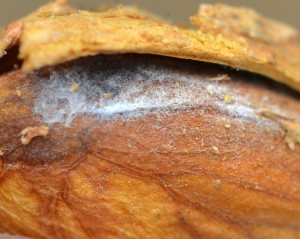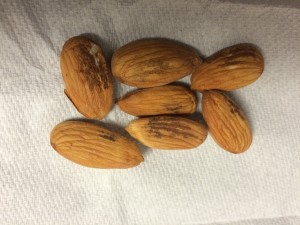
Rhizopus stolonifer, also known as the bread mold fungi, is a ubiquitous fungi. Within almonds, we often think of it as the Hull Rot pathogen, which can kill limbs through the movement of a produced toxin. Over the past harvest period, however, there have been some interesting kernel symptoms observed that have been found to be caused by this fungus as identified through isolations. The increased occurrence of these infections is thought to be due to the increased humidity experienced during the July, which most likely favored fungal growth.
The first set of symptoms observed was the white fungal growth on the surface of the kernel (figure 1). The initial infection begins as a light, white fuzz that grows, and if left long enough in suitable conditions, begins to develop black spores. When these lesions were submitted for isolation, they came back as Rhizopus stolonifer. This type of kernel infection rarely becomes a concern because as the kernel dries to a suitable percentage for storage (~6% moisture), the fungal growth usually dries out and is not visible. It does not create a food safety issue.

The second set of symptoms observed was a black or dark lesion that occurs on ‘Sonora’ kernels. These lesion tends to follow the “veins” of the kernel skin. The severity of kernel discoloring can vary, with most of the discolored kernels not providing an issue at processing. If, however, the infected areas are large enough, the kernels could get kicked out by the color sorters at the processors. When these kernels were submitted for isolation, we found both Rhizopus stolonifer and Aspergillus niger. Both of these fungi are common opportunistic fungi, and outside of the staining, the infected kernels do not pose a food safety concern.
Thankfully, opportunistic fungi infecting kernels does not always occur. This highlights basic disease epidemiology principles that even when the pathogen and host are present in the orchard, the environmental conditions must also be conducive for disease.

